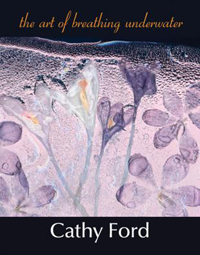Reviews
Poetry Review by Mark Silverberg
Cathy Ford, the art of breathing underwater (Salt Spring Island: Mother Tongue, 2010). Paperbound, 114 pp., $19.95.
Cathy Ford’s poems require a certain finesse, a certain mood and talent to read—and much of that talent has to do with letting go. Many proponents of the avant-garde believe that one of the main things needed to appreciate difficult, resistant, non-mimetic art is simply a willingness, an assent, a liberation from preconception. When we bring such willingness to Ford’s abundant but, at the same time, often mimetically spare poems, they offer many rewards. As Jane Munro notes in her introduction, the work is a kind of “soundscape underwater,” and if we want to hear it appropriately we need to “listen viscerally, listen visually, with the ear of the heart….”
Ford has been an important contributor to the West Coast experimental writing community for over four decades. A community and arts activist, teacher, editor, and the author of fourteen books of poetry, she is also a past president of the League of Canadian Poets and one of the founding members of its Feminist Caucus. Her commitment to feminist politics and poetics underwrites this book that, at over twenty years in the making, has the feel of a life’s work.
The characteristic Ford poem, employing long lines that recall Adrienne Rich’s reclamation of Whitman’s line in books like An Atlas of the Difficult World, often begins with a political context (disappearing species, environmental degradation, Kosovo, Belarus, or B.C.’s “highway of tears”). But, to its benefit, the work rarely stays within the headline, instead following a kind of lyrical, Woolfian “voyage out” into a submerged world of “seaglass, claret, azure and opalescent tideline” or the “miasma of icebound grief.” Though Ford is a political poet, her poems are at their best when they resist the narratives endemic to political ideology and, instead, work against narrative and description. The book’s least successful poems, mostly those in its last section, cling too closely to personal narratives. Ford’s strongest poems, on the other hand, reject mimesis for a lyrical and experimental mode that leaves the headline in view but, at the same time, moves past the always unsatisfying newspaper details into the unnameable space that proponents of écriture féminine have often associated with the oceanic:
forgive us our trespasses
iced hearts, trueline
haiku of carnelian, vermillion, watershot tears
A poem like “Blue Kosovo Angel” provides a good example of this dynamic. Though it begins, “First, the dead,” the poem refuses to linger on the bombed and displaced bodies that dominate the media and conventional “political” poetry. Instead, it offers a fleeting vision of an angelic face:
her splendour delicate as new perfume, enchanting
as a purpled sea breeze holds you crisp in its arms
chastens the windburnt skin around your eyes,
you look out from your little life, wondering.
The poem is both ephemeral and political, replacing the media vision with what the poem calls a “palimpsest for Kosovo,” a submerged image of “what survives after/what kills you.”
“Stillwater, Spillgate,” the central poem of the book, was composed over a period of fifteen years. The forty-five-part poem was inspired by “Homage to Nature,” an exhibition of forty-five “Landscape Kimonos” by Master Itchiku Kubota (Museum of Civilization, Ottawa, 1995). An
intricate life’s work, each of Kubota’s kimonos, which recreate “fleeting moments in the natural world,” took up to a year to complete. They were not put on public display for the first twenty years of the project. (Readers will recall that Ford hasn’t published a full-length book in
twenty-one years.) The poet responds to the silk kimonos (Ford explains in her introduction to the poem), seeing them as devices for the opening of “the female gaze, the feminist glimpse, the woman’s glancing—into the lives and unnatural deaths of women in contemporary society.” The fragmentary meditations on Kubota’s art are thus also political interventions in the “war against nature, and war against the bodies of women and children.” The challenge of treading the line
between poetry and politics is to avoid the twin pitfalls of overt discursiveness and covert lyrical evasion. While Ford seems more concerned with the latter trap, elsewhere chastising poetry that is “frustratingly non-specific, impersonal, pyrotechnical, or apolitical,” her poetry is most successful when it keeps its commitment to language experimentation and exploration front and centre. The poems stay with us not just as reminders of the events they elliptically point to, but when they remember, with the lyrical materiality of the kimonos as constant reference, that poems are made from words, not ideas, and that illusive, “difficult,” abstract language—lines forged underwater—can have a resonant relevance all its own. One section of “Stillwater, Spillgate,” written after the kimono entitled (in English translation) symphony of light, dancing danced, and dedicated to the victims of the Montreal Massacre, provides an apt summation of this resonance:
if there is any hope it is not in the city
in its bouquets of flowers, altars, utter grief-mongered
silence
but in the candle lit paper lanterns, streaming
ceremonially sailed out to sea, rivering
the voyage out
radiance cupped in our hands
the art of breathing underwater refuses Adorno’s famous contention that there can be no poetry after Auschwitz and instead holds a vital inquiry into the place for beauty after suffering and tragedy.
—Mark Silverberg









